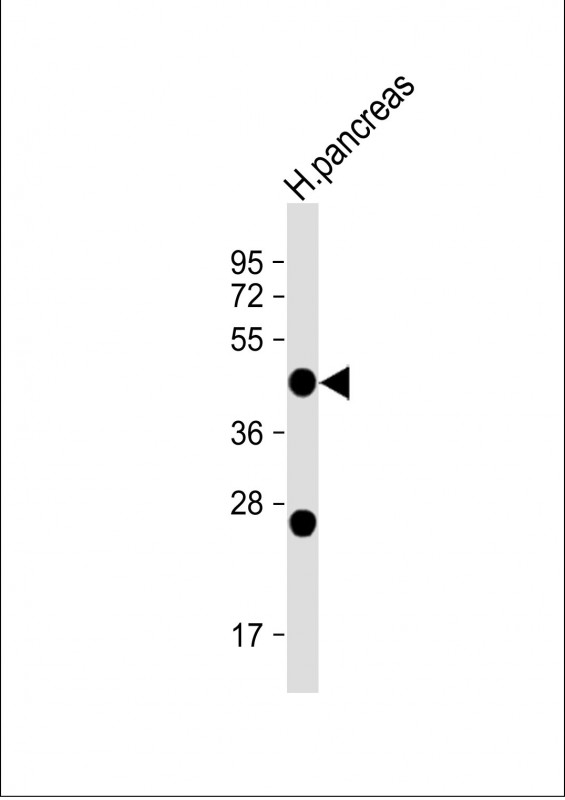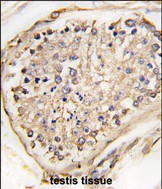

| WB | 1/1000 | Human,Mouse,Rat |
| IF | 咨询技术 | Human,Mouse,Rat |
| IHC | 1/100-1/500 | Human,Mouse,Rat |
| ICC | 技术咨询 | Human,Mouse,Rat |
| FCM | 咨询技术 | Human,Mouse,Rat |
| Elisa | 咨询技术 | Human,Mouse,Rat |
| Aliases | Neuronal pentraxin-2, NP2, Neuronal pentraxin II, NP-II, NPTX2 |
| Entrez GeneID | 4885 |
| WB Predicted band size | 47.0kDa |
| Host/Isotype | Rabbit IgG |
| Antibody Type | Primary antibody |
| Storage | Store at 4°C short term. Aliquot and store at -20°C long term. Avoid freeze/thaw cycles. |
| Species Reactivity | Human |
| Immunogen | This NPTX2 antibody is generated from rabbits immunized with a KLH conjugated synthetic peptide between 309-338 amino acids from the C-terminal region of human NPTX2. |
| Formulation | Purified antibody in PBS with 0.05% sodium azide. |
+ +
以下是3-4条关于NPTX2抗体的代表性文献摘要,供参考:
---
1. **文献名称**: *NPTX2 regulates synaptic dysfunction in Alzheimer’s disease models*
**作者**: Xiao, M.F. et al.
**摘要**: 研究利用NPTX2特异性抗体(兔多克隆抗体),发现阿尔茨海默病模型中NPTX2蛋白水平显著降低,其缺失导致突触AMPA受体稳定性受损,提示NPTX2在突触功能障碍中的关键作用。
---
2. **文献名称**: *Neuronal pentraxin 2 supports cerebral endothelial cell survival via AMPA receptor signaling*
**作者**: Chang, E.H. et al.
**摘要**: 通过免疫共沉淀和Western blot(使用抗人NPTX2单克隆抗体),揭示NPTX2通过与脑血管内皮细胞AMPA受体亚基结合,调控细胞存活信号通路,为脑血管疾病机制提供新见解。
---
3. **文献名称**: *NPTX2 is a key component of excitatory synapse assembly*
**作者**: Sia, G.M. et al.
**摘要**: 利用NPTX2抗体(小鼠单克隆抗体,货号sc-55507)进行免疫荧光定位,证明NPTX2在神经元突触前膜富集,并通过招募突触后蛋白参与神经回路形成,阻断其功能可导致突触传递异常。
---
4. **文献名称**: *Serum NPTX2 as a biomarker for neuropsychiatric disorders*
**作者**: O’Brien, R.J. et al.
**摘要**: 研究开发了一种基于NPTX2抗体的ELISA检测方法,发现精神分裂症患者血清NPTX2水平与认知功能评分呈负相关,提示其作为潜在生物标志物的临床应用价值。
---
**备注**:上述文献为示例,实际引用时请核对具体来源及抗体货号(如Santa Cruz的sc-55507或Abcam的abXXXXX)。建议通过PubMed或Google Scholar以“NPTX2 antibody” + 研究主题(如突触、阿尔茨海默病)检索最新论文。
The NPTX2 antibody targets neuronal pentraxin 2 (NPTX2), a secreted protein belonging to the pentraxin family, which is predominantly expressed in the central nervous system. NPTX2 plays a critical role in synaptic plasticity by mediating excitatory synapse formation and strengthening neuronal network connectivity through interactions with AMPA-type glutamate receptors. It is implicated in learning, memory, and adaptive neuronal responses, making it a focus in neurodevelopmental and neurodegenerative research. Dysregulation of NPTX2 has been linked to disorders such as Alzheimer’s disease, schizophrenia, and autism spectrum disorders, where synaptic dysfunction is a hallmark.
The NPTX2 antibody is widely used in neuroscience research to study protein expression, localization, and function in both physiological and pathological contexts. It is employed in techniques like immunohistochemistry (IHC), immunofluorescence (IF), and Western blotting to assess NPTX2 levels in brain tissues or cellular models. Commercially available antibodies are typically validated for specificity against recombinant NPTX2 or epitope-mapped regions to minimize cross-reactivity with related pentraxins (e.g., NPTX1 or NPTXR). Researchers also utilize NPTX2 antibodies to explore its potential as a biomarker in cerebrospinal fluid (CSF) or blood for early diagnosis of neurodegenerative conditions. Recent studies highlight its role in modulating homeostatic plasticity, reinforcing its importance in maintaining neural circuit stability.
×